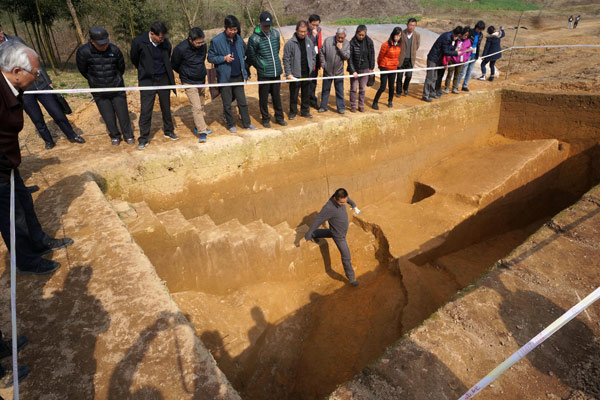
An archaeologist examines sections of unearthed ancient flood-control dams in Hangzhou, Zhejiang province. Wu Huang/for China Daily
Archaeologists have unearthed ancient flood-control dams, a series of sophisticated barriers constructed 4,700 to 5,100 years ago that mark the oldest water management system ever found in China.
The discovery among Hangzhou's Liangzhu relics was announced to the public on Tuesday by the Zhejiang Provincial Archaeological Research Institute.
"It reveals complex planning and construction skills and may create a new horizon for studies on ancient Chinese civilization," said Yu Bing, an expert with the Chinese Academy of Cultural Heritage.
Though a section of a dam was found in the 1990s, a major excavation from July to January unearthed 11 dams. The scientific team included archaeologists from the Zhejiang institute, Nanjing University and Shandong University.
The dams are from a period 1,000 years earlier than the time of Yu the Great, a legendry ruler of ancient China famed for flood control. No physical evidence of Yu's work has ever been confirmed.
Liu Bin, director of the institute, said the dams were found within a 100-square-kilometer area, with the longest surviving section running 6.5 kilometers.
"Its scale is bigger than any contemporary counterparts overseas, according to current knowledge. In ancient Egypt, there was a 4,000-year-old relic, but it included only one dam," Liu said.
Follow-up studies are continuing.
"It is not enough to get a panorama that relies only on field research of its layout and appearance," Liu said.
"For example, in-depth research on intersecting surfaces collected from two dams is ongoing. It will decode specific piling methods. And information about people's daily lives, which is hidden in the sediment, will be analyzed."
Liangzhu relics, first found in 1936, provide evidence of a sophisticated civilization lasting from 3300 BC to 2000 BC. The area is best known for its abundant jade.
"The world's water-management relics from roughly the same period of history that have been unearthed are mostly in arid areas such as ancient Egypt or Mesopotamia," Yu said. "But Liangzhu is on a humid southern bank of the Yangtze River, which is an unprecedented example."
However, there are still many unsolved puzzles.
"The age of the dams is basically indisputable now, but their function is still being debated among scholars," said Luan Fengshi, a professor from Shandong University.
"Basically, we don't believe it is likely that they were used for irrigation," Luan said. "Details of their construction and abandonment are yet to be confirmed."


















































